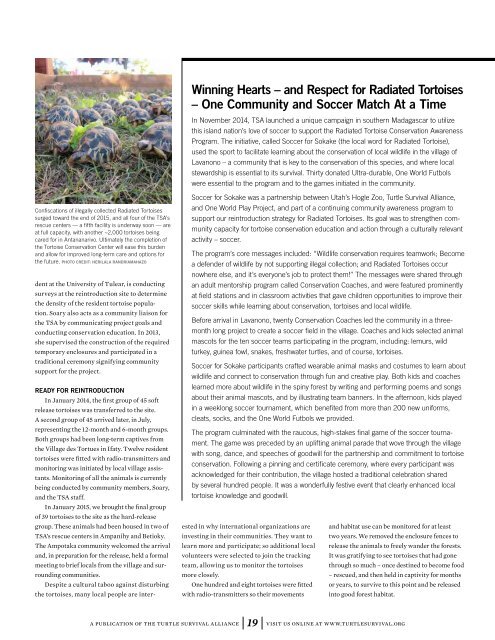Turtle Survival
2tUaeTbNi
2tUaeTbNi
You also want an ePaper? Increase the reach of your titles
YUMPU automatically turns print PDFs into web optimized ePapers that Google loves.
Winning Hearts – and Respect for Radiated Tortoises<br />
– One Community and Soccer Match At a Time<br />
In November 2014, TSA launched a unique campaign in southern Madagascar to utilize<br />
this island nation’s love of soccer to support the Radiated Tortoise Conservation Awareness<br />
Program. The initiative, called Soccer for Sokake (the local word for Radiated Tortoise),<br />
used the sport to facilitate learning about the conservation of local wildlife in the village of<br />
Lavanono – a community that is key to the conservation of this species, and where local<br />
stewardship is essential to its survival. Thirty donated Ultra-durable, One World Futbols<br />
were essential to the program and to the games initiated in the community.<br />
Confiscations of illegally collected Radiated Tortoises<br />
surged toward the end of 2015, and all four of the TSA’s<br />
rescue centers — a fifth facility is underway soon — are<br />
at full capacity, with another ~2,000 tortoises being<br />
cared for in Antananarivo. Ultimately the completion of<br />
the Tortoise Conservation Center will ease this burden<br />
and allow for improved long-term care and options for<br />
the future. PHOTO CREDIT: HERILALA RANDRIAMAHAZO<br />
dent at the University of Tulear, is conducting<br />
surveys at the reintroduction site to determine<br />
the density of the resident tortoise population.<br />
Soary also acts as a community liaison for<br />
the TSA by communicating project goals and<br />
conducting conservation education. In 2013,<br />
she supervised the construction of the required<br />
temporary enclosures and participated in a<br />
traditional ceremony signifying community<br />
support for the project.<br />
READY FOR REINTRODUCTION<br />
In January 2014, the first group of 45 soft<br />
release tortoises was transferred to the site.<br />
A second group of 45 arrived later, in July,<br />
representing the 12-month and 6-month groups.<br />
Both groups had been long-term captives from<br />
the Village des Tortues in Ifaty. Twelve resident<br />
tortoises were fitted with radio-transmitters and<br />
monitoring was initiated by local village assistants.<br />
Monitoring of all the animals is currently<br />
being conducted by community members, Soary,<br />
and the TSA staff.<br />
In January 2015, we brought the final group<br />
of 39 tortoises to the site as the hard-release<br />
group. These animals had been housed in two of<br />
TSA’s rescue centers in Ampanihy and Betioky.<br />
The Ampotaka community welcomed the arrival<br />
and, in preparation for the release, held a formal<br />
meeting to brief locals from the village and surrounding<br />
communities.<br />
Despite a cultural taboo against disturbing<br />
the tortoises, many local people are inter-<br />
Soccer for Sokake was a partnership between Utah’s Hogle Zoo, <strong>Turtle</strong> <strong>Survival</strong> Alliance,<br />
and One World Play Project, and part of a continuing community awareness program to<br />
support our reintroduction strategy for Radiated Tortoises. Its goal was to strengthen community<br />
capacity for tortoise conservation education and action through a culturally relevant<br />
activity – soccer.<br />
The program’s core messages included: “Wildlife conservation requires teamwork; Become<br />
a defender of wildlife by not supporting illegal collection; and Radiated Tortoises occur<br />
nowhere else, and it’s everyone’s job to protect them!” The messages were shared through<br />
an adult mentorship program called Conservation Coaches, and were featured prominently<br />
at field stations and in classroom activities that gave children opportunities to improve their<br />
soccer skills while learning about conservation, tortoises and local wildlife.<br />
Before arrival in Lavanono, twenty Conservation Coaches led the community in a threemonth<br />
long project to create a soccer field in the village. Coaches and kids selected animal<br />
mascots for the ten soccer teams participating in the program, including: lemurs, wild<br />
turkey, guinea fowl, snakes, freshwater turtles, and of course, tortoises.<br />
Soccer for Sokake participants crafted wearable animal masks and costumes to learn about<br />
wildlife and connect to conservation through fun and creative play. Both kids and coaches<br />
learned more about wildlife in the spiny forest by writing and performing poems and songs<br />
about their animal mascots, and by illustrating team banners. In the afternoon, kids played<br />
in a weeklong soccer tournament, which benefited from more than 200 new uniforms,<br />
cleats, socks, and the One World Futbols we provided.<br />
The program culminated with the raucous, high-stakes final game of the soccer tournament.<br />
The game was preceded by an uplifting animal parade that wove through the village<br />
with song, dance, and speeches of goodwill for the partnership and commitment to tortoise<br />
conservation. Following a pinning and certificate ceremony, where every participant was<br />
acknowledged for their contribution, the village hosted a traditional celebration shared<br />
by several hundred people. It was a wonderfully festive event that clearly enhanced local<br />
tortoise knowledge and goodwill.<br />
ested in why international organizations are<br />
investing in their communities. They want to<br />
learn more and participate; so additional local<br />
volunteers were selected to join the tracking<br />
team, allowing us to monitor the tortoises<br />
more closely.<br />
One hundred and eight tortoises were fitted<br />
with radio-transmitters so their movements<br />
and habitat use can be monitored for at least<br />
two years. We removed the enclosure fences to<br />
release the animals to freely wander the forests.<br />
It was gratifying to see tortoises that had gone<br />
through so much – once destined to become food<br />
– rescued, and then held in captivity for months<br />
or years, to survive to this point and be released<br />
into good forest habitat.<br />
a publication of the turtle survival alliance 19 visit us online at www.turtlesurvival.org


